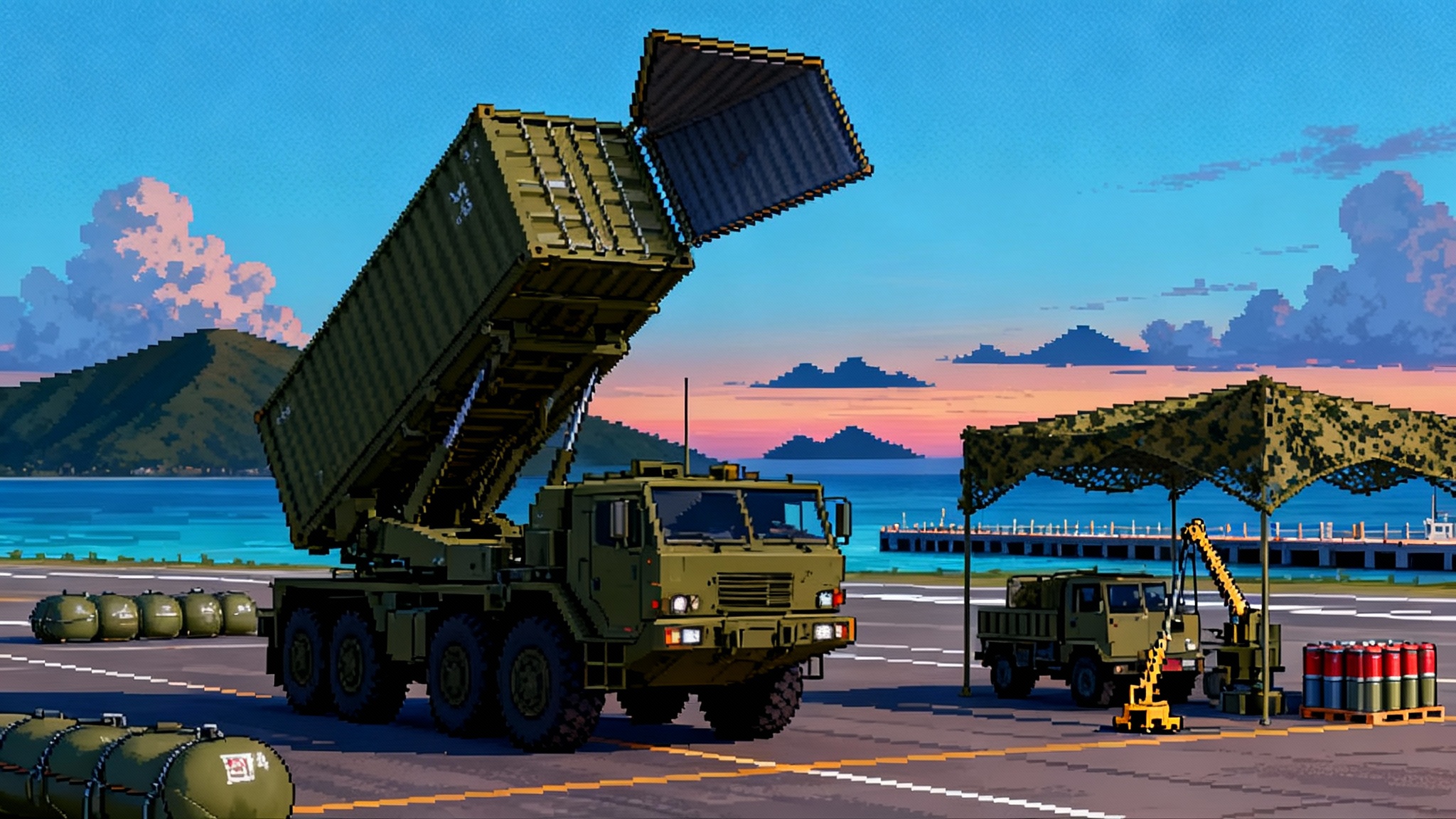Marines Make Counter-Drone Standard Issue in 2025 Rollout
In 2025 the Marine Corps made counter-drone defense standard issue, pairing an AI base-defense program of record with fielded NMESIS and MADIS at Balikatan. See how dismounted tools and smart missile software build a layered, affordable playbook.

The year counter-drone became standard issue
Two dates defined the Marine Corps shift from boutique counter-drone experiments to everyday kit. On March 7, 2025, the Corps awarded a ten-year, $642 million Installation-Counter small Unmanned Aircraft Systems contract to Anduril, turning base defense against small drones into a formal program of record. The Marine I-CsUAS contract award notice is dry reading, but its implications are sweeping: artificial intelligence software, sensors, and interceptors will be installed, sustained, and upgraded across Marine bases worldwide through 2035.
Three weeks later, the playbook moved from bases to the edge. In April 2025 the Marines deployed both the Navy-Marine Expeditionary Ship Interdiction System and the Marine Air Defense Integrated System during Exercise Balikatan in the Philippines. NMESIS rolled into the Batanes island chain near the Luzon Strait, marking its first deployment to the Philippines, while MADIS conducted live-fire training alongside Philippine forces. The NMESIS milestone is captured in an official release on its official NMESIS Batanes deployment release. MADIS’s debut outside the United States was highlighted by I Marine Expeditionary Force and Marine Corps releases as part of the exercise’s integrated air and missile defense event.
Read together, these events set the standard for 2025: counter-drone is not a special mission, it is part of every mission. The Corps is fusing base defenses, mobile systems, dismounted kits, and software-defined missiles into a layered architecture that any commander can use, from a littoral team on a coral airstrip to a major base handling heavy air traffic. That shared picture echoes the broader trend toward space-enabled command and control, as seen when SDA’s kill web goes live.
The new playbook, in plain language
Think about stadium security on game day. You do not rely on one gate or one metal detector. You layer many simple measures so that no single failure opens the whole venue. The Marines are doing the same with drones:
- See: low-power radars, radio frequency detectors, and cameras create an early-warning picture. On the bases that Anduril will harden under I-CsUAS, its Lattice software stitches these feeds to spot and track small drones automatically. At the tactical edge, Marine teams use compact sensors that run on the same mission tablets they already carry.
- Sort: artificial intelligence ranks what matters. A flock of birds and a hobby quadcopter over a parking lot get flagged differently from a fast mover diving at an ammunition pad. The software proposes the right tool for the job.
- Stop: the closest and cheapest countermeasure goes first. Electronic attack and spoofing for simple quadcopters. A burst from a 30 millimeter cannon or a Stinger missile from a MADIS Mk 1 when the threat pushes inside the perimeter. A guided rocket if the target is small and agile. The goal is to spend as little as possible per intercepted drone while keeping the runway, fuel farm, or convoy safe.
This is not about one superhero system. It is about the choreography that matches the threat to the right effector in seconds.
What actually showed up at Balikatan
- NMESIS brought the Naval Strike Missile on a remotely operated launcher. Originally designed to kill ships, NMESIS in the Batanes showed how a Marine Littoral Regiment can control key maritime terrain and deny a strait without a ship in sight. Even when it is not shooting, the system pushes targeting data into the wider force so that aircraft, surface ships, and coastal batteries share the same picture.
- MADIS put a modern short-range air defense section on Joint Light Tactical Vehicles. The Mk 2 vehicle is the brains, with radar and command and control. The Mk 1 is the brawn, with Stinger missiles, a 30 millimeter gun, and electronic attack. During the exercise, Marines and Philippine partners practiced live engagements of small drones and refined who shoots and when.
That second bullet is the quiet revolution. It shows how ground units now plan drone defense the way they plan route security, with standard checklists and battle drills instead of ad hoc fixes.
The affordable layer cake
Winning the drone fight is as much about the bill as the kill. The new Marine approach deliberately pairs low-cost defenses with a few high-end shots, an approach echoed in systems like Leonidas fells 49-drone swarm.
- Dismounted kits: Handheld jammers like Dronebuster have become common tools for gate guards and patrols. They are light, battery powered, and effective against many commercial quadcopters. They also buy time, forcing a drone to pause or drift while a gun, rocket, or missile sets up a clean shot.
- Vehicle sections: MADIS sections travel with maneuver units and stand up around expeditionary bases. Because they integrate radar, electronic attack, guns, and missiles on one display, a two-vehicle section can defeat a surprisingly diverse set of targets without calling for help.
- Smart rockets: The Advanced Precision Kill Weapon System, built by BAE Systems, turns a 70 millimeter rocket into a laser-guided round. With a proximity fuze and a counter-drone flight profile, APKWS gives pilots and some ground launchers a way to swat Class 1 and Class 2 drones at a price that makes sense for training and combat.
- Smarter missiles: Lockheed Martin’s Joint Air-to-Ground Missile is getting software and launcher upgrades that let it tackle more than tanks. A quad-launcher and counter-unmanned aircraft system demonstrations indicate where this is going next. When an armed drone or loitering munition needs a one-shot stop, a JAGM with the right seeker modes gives that option.
- Maritime reach: NMESIS does not hunt drones, but it matters to drone defense. A mobile anti-ship battery that can ride a C-130 aircraft, roll out, and control a chokepoint creates a safe bubble for allied ships and aircraft to operate. That reduces the number of incoming threats in the first place and complements developments like Typhon land Tomahawk and SM-6.
The key is match-ups. Use jammers or a 30 millimeter burst for a cheap quadcopter. Save missiles for the threat that would otherwise slip through.
Why artificial intelligence sits at the center
Artificial intelligence is not an add-on. It is the traffic cop that keeps the layers from tripping over each other. On a modern base you might see dozens of radar and camera feeds, plus radio frequency sniffers, plus human spotters. No human can manually relate all that while drones move in three dimensions. The I-CsUAS software tier takes that cognitive load, displays one picture, and suggests the cheapest effective shot. That is why the March 2025 award matters so much. It funds the connective tissue that turns a box of parts into a defense system.
Artificial intelligence also closes the loop. After each engagement, the system learns. If a certain quadcopter model shrugs off a specific jamming technique, the software de-prioritizes that choice next time. If a particular rocket or cannon burst pattern performs better in crosswinds, the software adjusts the firing solution. The result is a defense that gets sharper with every rep.
What this means for joint tactics in 2026 and 2027
- Littoral base design changes: Small coastal sites in the First Island Chain will plan drone defense like they plan camouflage and concealment. Expect dispersed radar heads, low-profile camera masts, and handheld jammers in every squad room. Marines will rehearse counter-drone actions on contact just as they rehearse casualty evacuation.
- Aviation and air defense integration: Expect tighter pairing of Marine aviation with MADIS sections. If a swarm threatens a forward arming and refueling point, the first layer will jam and cannon the front of the swarm, while aircraft crew chiefs cue APKWS from nearby platforms to pick off stragglers. Stingers and JAGM handle the rare hard target that gets through.
- Navy and Coast Guard links: NMESIS batteries will share tracks with ships through common messaging, which lets surface combatants avoid wasting a Standard Missile on a target that a nearby MADIS or base rocket can kill cheaply. Conversely, a destroyer can warn a Marine base of a fast-approaching drone boat or aerial threat picked up over the horizon.
- Spectrum discipline becomes a survival skill: Units will train to turn sensors and jammers on only when needed, then move. Emissions are beacons; the side that learns to hunt by listening will have an edge. Artificial intelligence will help by pre-computing likely threat paths so that sensors do not need to scan at full power all the time.
Procurement and sustainment: what changes now
- Buy software first, then sensors: The base-defense contract is structured to install and sustain software and the hardware it controls. That encourages competition at the component level. If a new radar or camera shows up, it can be added without rewriting the whole stack.
- Field test cycles tighten: Expect quarterly software drops, not yearly. The Marine Corps and industry will need standing test ranges that can fly many commercial and improvised drones safely, score engagements, and push data back into the algorithms.
- Munitions copy gets smarter: Program managers will track not just stockpiles, but cost per intercept by threat type. That will drive buys of proximity-fuzed rockets and selected missiles, with explicit targets for training shots so that units can practice the full engagement sequence.
- Logistics for the last 100 meters: Batteries, spare jammer heads, and replacement proximity fuzes will be the consumables of drone defense. Units will add those items to their standard 96-hour packages for expeditionary operations.
The Marine rifle company in 2026: a practical loadout
Picture a rifle company on a remote airstrip with a Littoral Anti-Air Battalion section nearby. What do Marines actually carry and stage for drone defense?
- A handheld jammer per squad, with extra batteries on the same charging plan as radios and tablets
- A tablet app that displays the local air picture and suggests tactics based on the latest software release
- A small camera and radio frequency sensor kit per platoon, on tripods that are easy to hide and move
- A gun truck with a stabilized cannon and optics that can track and fire short, smart bursts
- An attachment to a MADIS section that can be called by voice or chat for a missile shot when needed
- A box of proximity-fuzed 70 millimeter rockets staged at the forward arming point for fast turns
The point is not to turn every Marine into an air defender. It is to make every Marine unit able to survive and keep fighting in airspace that is full of cheap threats.
What leaders can do now
- Rehearse the drill: Write a three-step counter-drone battle drill for your unit, post it by the radios, and run it at every field exercise. Keep it simple: see, sort, stop.
- Demand the data: Ask for after-action data from every drone engagement in your unit and from partner units. What worked at your range will not always work near the sea or in the mountains. Make data-driven changes.
- Audit the power plan: Verify that your charging plan covers jammers, tablets, sensors, and the new radios you already rely on. A dead jammer is just extra weight.
- Practice mix-and-match: Plug different sensors and effectors into your command-and-control kit during training. If the software is open, new hardware should be easy to add. Make that true in practice.
The bottom line
In 2025 the Marine Corps stopped treating drones as someone else’s problem. The March base-defense award gave the service a funded backbone of artificial intelligence, sensors, and sustainment. The April deployments at Balikatan proved that mobile systems and allied tactics can meet real threats in real places. The next two years will be about scale and discipline. Units that practice the layered playbook, pair low-cost shots with smart software, and keep their power and training plans tight will bend the cost curve in their favor.
Drones are not going away. The good news is that the Marine solution does not rely on fragile silver bullets. It relies on a stack of simple, connected moves that any unit can learn, improve, and repeat. That is how you turn a breakthrough into a standard issue habit.







